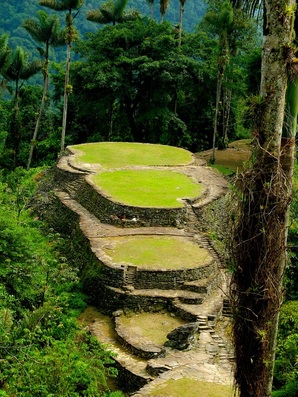 La Cuidad Perdida
La Cuidad Perdida Santa Marta & DumPster Kitty
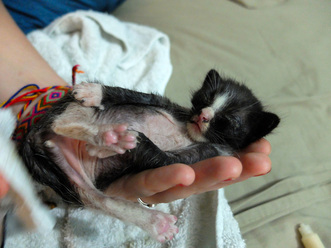 TINY guy
TINY guy  La Cuidad Perdida La Cuidad Perdida After our time in San Gil we were ready to head north to the Caribbean and spend some time lounging on a beach, but not before earning it. We arrived in Santa Marta early in the morning and settled into a hostel near the main market area. At first glance the city was pretty terrible: smelled of urine and rotting garbage mixed with thick black car exhaust, noisy vehicles, sketchy people, etc. I had no interest in walking around so after inquiring into “La Ciudad Perdida” (the Lost City) five-day trek through the jungle, I decided to relax and read a book for the rest of the day. Santa Marta & DumPster Kitty TINY guy TINY guy Andrew went to the bank machine and for a little walk around our area. I had expected him to take longer but after 10 or 15 minutes he barged into the room panicking, with something tucked away in his shirt. At first I thought it was a mouse or a small rat, Andrew just mumbled that he had found it screaming on a sidewalk and could barely explain that no one seemed to care and someone made fun of him for picking it up! It was a TINY kitten. Couldn’t have been more than 4 or 5 days old, with eyes still closed and one of them swollen to half the size of its head. Its hair was thick with dirt and smelled like human urine! Our hearts broke and we didn’t know what to do. Feeling like this kitten urgently needed some food, we left the hostel in search of a veterinarian. It took us far too long to find one but we eventually did after wandering through nasty smelly sweaty streets and market stands. We bought a container of kitten milk powder that you just add water to and a syringe we could use to try and feed him. We hurried back to the hostel and sterilized the syringe. Using a damp towel I cleaned the kitten as best I could while Andrew mixed some milk. It took some time to convince the kitten to eat from the syringe, but with patience we got the job done.
4 Comments
After a long bus ride from Mendoza, we spent a day and night stretching our legs and checking out Córdoba. Seemed like a reasonable place but, once again, a fairly big city and so not our cup of tea. Preferring to spend some time bein’ chili in some of the nearby smaller towns, we decided to head to Capilla del Monte (“Chapel of the Hill” in Spanish). A quaint and sleepy town of just over ten thousand, Capilla del Monte is known internationally as a hotspot of UFO and other paranormal activity. We thought maybe we’d have better luck with the ETs after coming up short in Pisco…
 view just outside of town view just outside of town As we made our way south from Atacama, we decided to take a bus break and spend a night in La Serena. Flipping through our Lonely Planet for things to do around there, we were excited to learn that the nearby Elqui Valley is famous as a hot spot for paranormal activity, with numerous reported UFO sightings and a population of crystal-power practitioners. The valley also boasts production of some of the best pisco (a liquor made from distilled grapes) in Chile. Hoping to get in on the action, we threw on our tinfoil helmets and caught the next bus to Pisco Elqui. 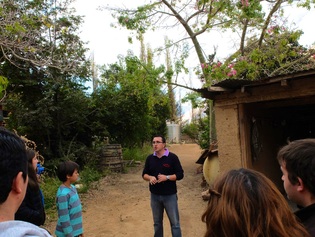 what the heck was he going on about? what the heck was he going on about? Although we didn't end up meeting any obvious extraterrestrials (we weren't sure about a few of the locals), we did see some excellent starry night skies while relaxing in our hostel's garden. We also gained some insight into how pisco is made by taking a tour of the distillery just outside of town. This is what I learned from the hour long tour: pisco has something to do with grapes, and it's painfully boring to sit through a tour when you can't understand what the tour guide is saying. Although our spanish isn't terrible, we have a hard time making out the Chilean accent, especially when people (such as our mile-a-minute tour guide) speak too quickly. Despite our powerful desire to sneak away and run, we stuck it out until the end and scored a few tiny free samples. When you haven't had a paying job in almost a year, your perception of the value of time becomes very skewed. 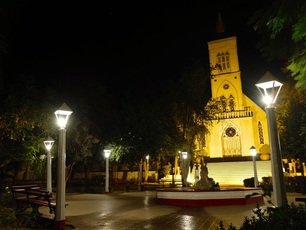 Pisco Elqui itself is a nice and quaint town, a good place to be chili and enjoy the surrounding dry and hilly landscape. There's something about sitting in the eerie silence while watching the first few stars appear above the neighbouring mountains that makes you feel like there may indeed be something out there... though the bottles of pisco nectar (like a very sweet wine) may have had something to do with it. After a couple nights of failed alien-spotting, we were ready to get back on the road and continue south to Santiago and beyond! If someones bein' mean, Hit them with a bean- flavoured fart. ~Mandrew To view the above photos in a new window, click here.
 an ayahuasca-inspired wall-hanging? an ayahuasca-inspired wall-hanging? A number of times over our past months in South America, we've come across references to an herbal drink called "ayahuasca". In a traditional ceremony led by an indigenous shaman, participants take ayahuasca and are then whisked away on an epic journey of self-discovery and flowery hallucinations. After numerous recommendations from people we've met along the way, we finally decided to see what all the fuss is about. The following recounts in detail what turned out to be an incredibly intense and emotional adventure that took place during a three day "spiritual retreat" near Cuzco, Peru. In deciphering my wildly scrawled notes from the retreat while recounting the experience, I’ve realized how bizarre the whole experience must sound to someone who hasn't been through it. All I ask is for readers to keep an open mind… at least until reaching the end, after which they’re free to call me all sorts of critical and creative names. Enjoy! ~ Mandrew Background ayahuasca being prepared over the fire ayahuasca being prepared over the fire Ayahuasca (“death’s rope” in the Quechua language) is a species of vine found in the Amazon Jungle and has a rich history of use by shamans as a means of communicating with the spirit world. In Ecuador and Peru especially, wild legends and stories about shamans are commonplace. It’s said that ayahuasca opens a doorway into an alternate dimension, allowing skilled shamans to acquire objects of power or receive guidance from extra-dimensional beings. I’ve heard tell that powerful shamans can physically transform themselves into jungle animals or even remotely poison or kill people through the spirit dimension. Such ideas have been around for thousands of years and are often found depicted on ceramics, textiles, and rock art uncovered from these ancient cultures.
Just like in many other indigenous groups throughout the world, shamans (a.k.a. medicine men, druids, or witchdoctors) are men of power, highly revered in society and often relied upon for their spiritual knowledge and healing abilities. Throughout the Amazon Basin, a skilled shaman is one who, with the help of ayahuasca, can successfully interpret and control the spirit world, and in doing so identify and remove the negative spirits that are the root cause of one's ails (and hopefully prevent other evils from entering while the portal is open). In modern day, ayahuasca remains widespread in Ecuador, Peru, Colombia, and Brazil, not only as a rite of passage amongst indigenous cultures (our Shaman's first experience was at the tender age of seven), but also as a treatment for mental or emotional conditions, a means of better understanding one's self, and, of course, a hippy-dippy trip for curious backpackers. Some families gather every year for an ayahuasca ceremony as a means of maintaining a healthy, mind, body, and spirit. There's even a religion in Brazil in which members drink ayahuasca tea at weekly gatherings. Many people who have taken ayahuasca claim that it opens up a connection with the energy of the universe, allowing them to overcome difficult crises or discover their true purpose in life. I agree - it all sounds pretty nuts!  Nazca Lines, including a "spider" figure Nazca Lines, including a "spider" figure The more we see and do in Peru, the more we’re in awe by the magic and mystery that can be found around every corner. It seems like just about every place we visit has some new enchantment to offer, be it the colourful designs covering the traditional clothing, the continuing belief in traditional spiritual and medicinal practices, or the archaeological remains of ancient civilizations. Nazca is certainly no exception to this, with an unmistakable air of archaeological mystery surrounding the city. 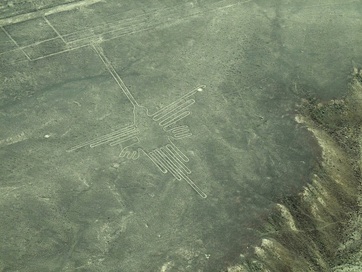 another geoglyph - the hummingbird another geoglyph - the hummingbird Near the southern coast of Peru and surrounded by a Martian desert landscape, at first glance there really wouldn’t be anything special about the place. Speeding by along the Southern Pan-American Highway, you’d only really feel compelled to stop to refill or gas or for food. Hiking atop the nearby hills or flying overhead, however, you’d quickly realize that there’s much more to Nazca than meets the ground-level eye: covering an area of almost a hundred square kilometers of the desert plateau to the west of Nazca are a collection of lines, figures, and shapes drawn into the sand as if by a giant finger into the dust of a giant windshield. Created by the Nazca people between 400 and 650 A.D., some of these shapes represent animals common to the area (spiders, monkeys, fish, birds) – others, however, are simply massive geometric figures that have no apparent meaning, though there are a few theories floating around… 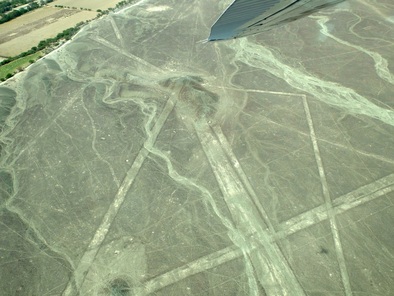 some more Nazca lines - what do they mean? some more Nazca lines - what do they mean? Of all the mystery surrounding the Nazca lines, the “how” is actually quite easy. A thin layer of reddish-brown pebbles covers most of the plateau – by removing this layer (typically between 10 and 15cm worth of debris) the much whiter layer of clay beneath is exposed. All you’d need is a few assertive mathematicians and enough strong backs to do the work, and presto – Nazca lines. The bigger question here is obviously, “Why?”. Why dedicate so much time and effort into creating something that can’t truly be appreciated by any of the people responsible for creating it?
|